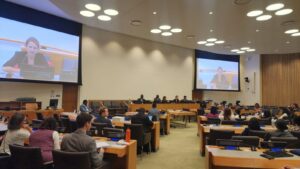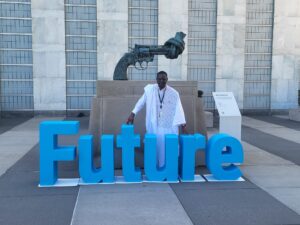Day 1
The Summit of the Future started today (Friday 20th Sep) with the first of two Action Days that are taking place before the high-level Summit starts on Sunday. Today was dedicated to youth and kicked-off with an opening ceremony and youth-led afternoon with numerous side events. The key topic under discussion was how to ensure meaningful youth engagement in decision-making and the implementation of Pact for the Future, the key outcome document from the Summit.
Youth flooded the UN building and there was a palpable energy and optimism to the place. Keeping the innovation and creativity that was so present today alive over the rest of the Summit will be key to its success.
GNDR side event
A key highlight of the day was GNDR’s side event. GNDR held a side event within the UN building in collaboration with UNDRR, The Kenyan Government, ActionAid, The Stakeholder Engagement Mechanism to the Sendai Framework (SEM), the Major Group for Children and Youth (MGCY), and others. The event discussed the importance of youth engagement in resilience building and risk-informed development. GNDR moderated the event and the panellists included:
- George Osaso, State Department for Youth Affairs and Creative Economy, Kenyan Government
- Gloria Bulus, Executive Director of Bridge that Gap Initiative and GNDR National Focal Point for Nigeria
- Irfan Pullani, Alumni President, UN University for Peace
- Ms Patrícia Iglecias, Chief Sustainability Officer and Professor of Law, University of São Paulo
- Eugine Okanda, Kenya Youth Representative, Africa United Nations Youth Delegate
The event enabled an interactive dialogue with many youth delegates taking the floor and highlighted how the youth are a powerful force that can bring creativity and innovation to the building of resilience. The importance of intergenerational dialogues, an intersectional understanding of youth and a whole of society approach to risk informed development are but three of the core messages that came from the event.

Our side event at the Summit of the Future: The Future of Multiculturalism: Empowering Youth and Building Resilience
Day 2
The programme for Day two of the Action Days focused on:
- A Digital Future for All
- A Peaceful Future for All
- A Sustainable Future for All
Meanwhile, in the background the negotiations on the Pact for the Future were still ongoing, with no final version of the outcome document yet agreed. Member States disagreed over different elements of the Pact, including the paragraphs on climate and the proposal to create emergency platforms. It is hoped that an agreement will be reached tonight before the high-level Summit starts tomorrow.
Key highlights of the day:
- A session on global governance reform with Mary Robinson (ex President of Ireland) and moderated by Heba Aly (journalist and host of the Rethinking Humanitarianism podcast). During this event innovative ideas were presented on:
- Security Council reform
- the importance of the Emergency Platforms
- the need to declare a planetary emergency in relation to the climate crisis
- how to reform the COP process to accelerate climate action
- and more…
- A session organised by C4UN (Coalition for the UN we need) on the future of ImPACT Coalitions. Here Maria Fernanda Espinosa (ex-president of the UN General Assembly) and others spoke on what needs to happen after the Summit. They highlighted:
- The need to ‘unpack’ the Pact and develop roadmaps for the implementation of key actions within the Pact
- The crucial role of civil society in the implementation of the Pact and a whole-of-society approach to its implementation.
- How coalitions of support with supportive governments around the proposal for an envoy for Future Generations would help raise ambition and action
Day 3
The high-level Summit kicked off with the adoption of the Pact for the Future by the General Assembly. It was the 5th revision and was adopted without any mention of the Emergency Platforms that the Secretary General had championed to help the international system better respond to complex global shocks. It is unclear why it was not included in the final version but it is likely that Member States were concerned that the Emergency Platforms could seek to supersede national sovereignty, whilst UN agencies were likely also concerned that it could cause duplication or undermine their mandates.
Beyond the adoption of the Pact there were two main sessions:
- Transforming global governance and turbocharging the implementation of the 2030 Agenda for sustainable development
- Enhancing multilateralism for international peace and security
Across the two sessions governments spoke of the need to reform the international system to be fairer and more just and to better serve the needs of today’s world. There was a strong call for change and for reform of the UN and our global financial institutions.
GNDR’s Statement:
“GNDR is a global network of 1,800 civil society organisations working globally on risk and resilience.
We welcome the call within the Pact to close the SDG financing gap and for funding to be accessible to developing countries.
We also welcome the reference to the need to localize sustainable development.
However, if we are to achieve the SDGS and localise sustainable development this finance cannot be ‘business-as-usual’ development finance.
Investing in disaster risk saves lives and money in the long term, but too little financing goes to disaster risk reduction. Furthermore, local actors understand their needs best and know how to build inclusive resilience, but too little finance is accessible to the local communities that are on the frontlines of disaster risk and climate change.
As we look to the financing for development conference next year and to close the finance gap, we need to make sure that our investments are future-proofed, that they drive risk-informed development, and that they are accessible to local communities and marginalised groups, including, to people of all genders, to indigenous peoples, and to people with disabilities.
Investing in risk-informed development requires analysing the complex threats that people face and understanding vulnerabilities and capacities. And this needs to be understood also from the perspective of local communities.
In addition, development funds need to be made accessible to local communities, and to marginalised groups within. Funds need to be earmarked for local actors through direct access windows, and funding application processes need to be streamlined.
Localisation requires more than words, or even political intention, it requires finance; and this finance needs to flow to women led groups, indigenous peoples, people with disabilities and other key groups. Only then will development funding truly work for all and build resilience.”

Kabine Doumbia, President of NGO ASRAD, Mali, GNDR member, at the United Nations in New York for the Summit of the Future.
Day 4
The Summit of the Future closed on Monday giving way to the start of the United Nations General Assembly (UNGA). The Pact for the Future was adopted along with a Declaration on Future Generations and a Global Digital Compact. Below are our key takeaways:
- It is no small feat that a Pact that addresses the world’s most complex challenges with concrete actions was agreed upon by 193 countries. For this, the international community can be proud.
- However, we must also acknowledge that this Pact falls short on the innovation and vision that we need. We needed more on climate, more on addressing complex challenges and more on institutional reform.
- Now as the Summit ends the focus is on implementation, and civil society has a huge role to play in this.
- The People’s Assembly was a highlight of the Summit. It was held on the sidelines and brought civil society together to discuss the future that we need. It highlighted how we need to work together, to move out of our silos and to strengthen the power and voice of the people.
I asked GNDR members present at the Summit to share their key messages to Member States. Please see their insights below:
“Member States and those with power are disconnected from the reality – this needs to change. We also need to see greater international leadership in the major conflicts of the world. We need the leadership from the UN to bring peace”
Kabine Doumbia, President of NGO ASRAD, Mali, GNDR member
“No nation can alone address the climate crisis, the health crises, pandemics and ecosystem collapse – to name just a few. We need collaboration, greater equity in our systems and a human rights approach”
Gloria Kasang Bulus, Founder, Bridge That Gap, Hope For Africa Initiative, GNDR Focal Point Nigeria
Gloria spoke on the GNDR side event (see update from day 1) as well as a Centre for Community Impact and Sustainability side event titled: “Youth leadership for climate action & peace building: a pathway for sustainable development”, held on 19 September 2024.